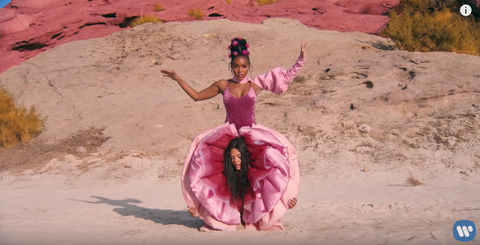Love , Sex and Relationships
What’s the Difference Between Pansexuality and Bisexuality?
While pansexuality and bisexuality are often used interchangeably with one another, they actually mean two different things, explains Tanya M. Bass, PhD, sexologist. While both describe sexual orientations, bisexuality is rooted in a binary system of gender identities, Bass explains. On the other hand, pansexuality encompasses attraction (either sexual, romantic, physical, and or spiritual) towards members of all gender identities and expressions and is not rooted in the binary.
This content is imported from {embed-name}. You may be able to find the same content in another format, or you may be able to find more information, at their web site.
Binary systems refer to gender identities like male and female, or man and woman, Bass explains, so someone who identifies as bisexual would be attracted to people of their own gender and another gender. However, because there are many valid gender identities beyond male and female, pansexuality refers to attraction to all genders, including gender identities not included in the binary.
“Gender being the common factor is often why many individuals do not ascribe to bisexuality,” explains Bass, adding, “because it is often not ‘gender’ that determines the attraction for some.” The difference in bisexuality and pansexuality can also be based on how the person themselves identifies, rather than just attraction towards others. If someone identifies as a gender identity not within the binary system, then that could also be a reason why they would identify as pansexual rather than bisexual.
Beyond the differences between bisexuality and pansexuality, Bass also notes that some folx may identify as ‘bicurious’ which means they have a strong curiosity toward experiencing attraction to people of the same gender or sex as themselves, beyond heteronormative experiences. Being bicurious is sometimes referred to as questioning, Bass says.
Both pansexuality and bisexuality can be “invisible,” Bass says, and subject to marginalization, erasure, and challenges, so it’s important to recognize both bisexuality and pansexuality and respect these orientations and the nuances between the two.
Pansexuality in Pop Culture
Recently, Janelle Monae came out as pansexual, telling Rolling Stone that: “Being a queer black woman in America, someone who has been in relationships with both men and women – I consider myself to be a free-ass motherfucker.” Monae elaborated that she used to identify as bisexual, but “then later I read about pansexuality and was like, ‘Oh, these are things that I identify with too.’ I’m open to learning more about who I am.” Meanwhile, while pansexuality seems to have resonated with Monae, bisexuality is still alive and well. While mainstream media has a history of painting people as either straight or gay, bisexual characters such as Toni Topaz in Riverdale demonstrate that society is finally waking up to other orientations. So, what is the difference (and similarity) between pansexuality and bisexuality?
What is pansexuality?
Pansexuality means an attraction to people regardless of their gender. “Their pattern of attraction does not generally include what someone’s gender is,” says sex therapist Dr. Liz Powell. So, a pansexual person may be attracted to their own gender, as well as other genders. However, someone’s gender is not a requirement or determining factor of whether or not they want to date or sleep with you. Sex therapist Dr. Kelly Wise defines pansexual as, “someone who is attracted to people regardless of gender or biological sex. That is irrelevant. Pansexuality holds space for the idea that gender is very fluid.”
Remember, while sex is typically assigned by doctors at birth depending on genitals, gender is a social construct. People should be able to identify with whatever gender they feel best suits them, be it male, female, non-binary, genderqueer, or genderfluid regardless of what the doctor in the birthing room says. A sexual orientation, such as pansexuality, is different than gender identity, but for pansexuals, gender identity is not what makes them into (or not into) someone. Dr. Powell points out that as it’s a newer term, younger generations, such as Generation Z may be more likely to identify as pansexual over bisexual.
What is bisexuality?
In most ways, bisexuality is the same as pansexuality. “Bisexuality is defined as attraction to people who are of the same gender and people of a gender other than your own. So that can mean any two or more genders,” Dr. Powell says. There is a lot of biphobia, misconceptions about bisexuality, and bi-erasure (an effort to remove the label or general ignoring of bisexuality) both within straight society and the LGBTQ community. One of these misconceptions is that bisexuality reinforces the gender binary, or that bisexual people only date cis people (someone whose gender identity matches the sex they were assigned at birth). “There is a popular misconception that bisexuality means an attraction to two genders. There are occasionally some bi folks who are only into cisgender people, but I think those folks are the exception and not the rule,” Dr. Powell says.
While the term bisexual may have been created in an era where gender was not understood as it is today, the “bi” in bisexual doesn’t mean that all bi people only date on the binary. It’s true that some pansexual people prefer pansexual over bisexual due to the prefix, but others believe it’s important to continue to identify as bisexual in an effort to fight bi erasure. “I’ve occasionally gotten some flack from pansexual people for continuing to identify as bisexual,” Dr. Powell says. “They’re like, ‘You’re reinforcing the gender binary,’ and I’m like, ‘That’s not actually what bisexual means, just the way that pansexuality doesn’t mean that you’re attracted to cookware.’”
Not only can bisexual people be attracted to trans and non-binary folks, but as with pansexuality, there are trans and non-binary people who identify as bisexual. “If you’re someone who chooses bisexual as the identity that fits you best, then that’s totally fine. There are lots of people who are non-binary who are bisexual. That doesn’t mean that you are reinforcing the gender binary. It doesn’t mean that you are less enlightened than pan folks, there’s no identity that makes you automatically more enlightened. It’s just about which identity aligns best with who you are and how you work.”
What else should I know?
Some bisexual and pansexual people also identify as queer. Queer is an umbrella term for a sexual orientation outside of the heterosexual norm that has political and LGBTQ activist roots. Not only was the word once a slur that has been reclaimed but identifying as queer often comes with a sense of community for many. You can identify as pansexual or bisexual and queer (or all three), or simply stick with queer.
So if you’re into more than one gender, how do you know which is the most appropriate label for you? Well, which word do you like best? Which one feels like home when you use it? Whatever that is, then that’s the right label for you. And just like Monae, if you identify as bisexual, but then learn about pansexuality and thinks that’s more appropriate for you, or vice versa, you’re allowed to change your labels. Such orientations may not be merely a phase (another common misconception), but they can be part of an exploration of your sexuality.
Follow Sophie on Twitter.
This content is created and maintained by a third party, and imported onto this page to help users provide their email addresses. You may be able to find more information about this and similar content at piano.io
Sex & Relationships – Cosmopolitan
Original Source Read More



